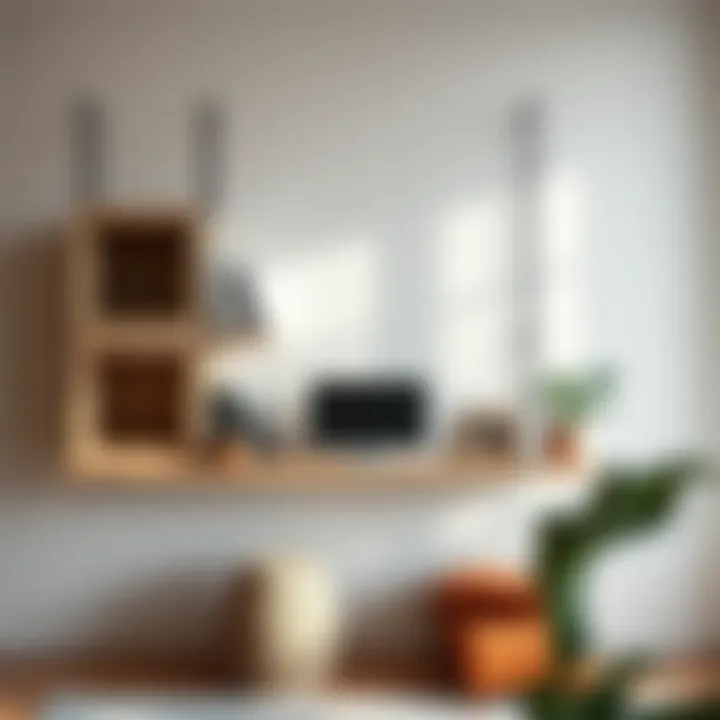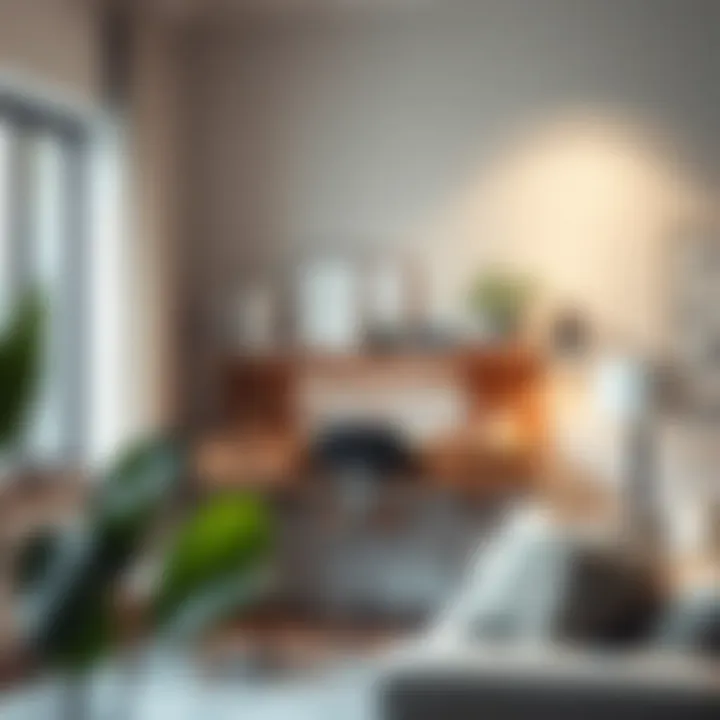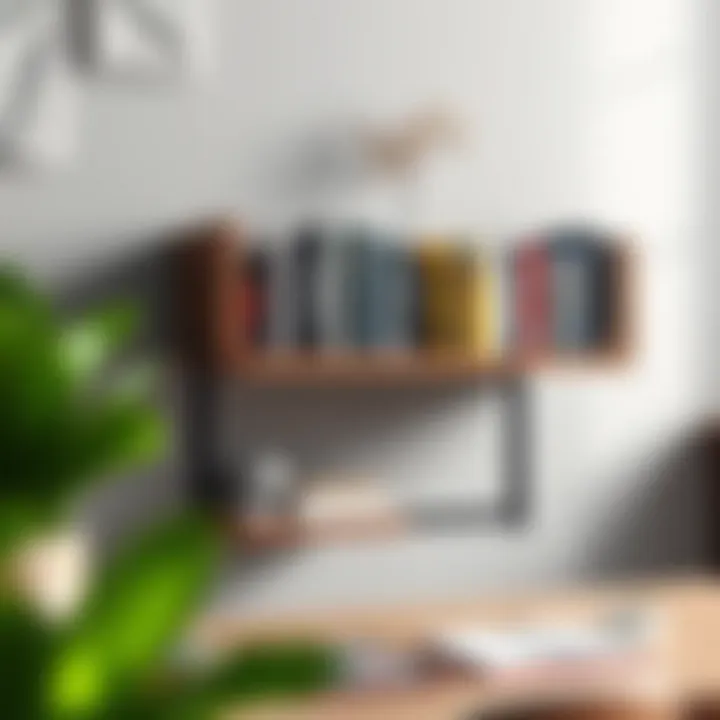Floating Desk Bookshelf: Merging Style and Utility


Intro
In an age where space is often at a premium, the integration of functionality and aesthetic appeal has taken center stage in interior design. For many homeowners, the challenge lies in maximizing available space while maintaining a stylish and organized environment. Enter the floating desk bookshelf, a unique creation that serves not only as a practical solution but also as a focal point in any room. This article explores the various dimensions of floating desk bookshelves—from their practical benefits to design tips, and even potential pitfalls—to guide readers in making an informed decision about adding these innovative pieces to their homes.
Furniture Styles and Trends
Modern design ideals often emphasize clean lines and simplicity, fostering a desire for pieces that blend seamlessly into any interior. When it comes to floating desk bookshelves, those principles are front and center. Their minimalist style complements modern interiors, standing in sharp contrast to the more ornate furnishings of traditional design.
Modern vs. Traditional: Understanding the Key Differences
Modern furniture often incorporates sleek materials like glass and metal, creating an airy feel. Floating shelves fit snugly against walls, freeing up floor space and giving an illusion of openness. Conversely, traditional designs favor heavy woods with elaborate carvings and textures, typically dominating the room.
Thus, if you are leaning toward modern aesthetics, you should look for floating desk bookshelves made from lighter materials or in neutral colors. However, for those whose hearts are set on the traditional look, integrating vintage floating shelves—perhaps reclaimed wood—can provide a charming juxtaposition.
Top Furniture Trends to Watch in
As the year progresses, several furniture trends have started to gain ground:
- Sustainable materials: Consumers are increasingly inclined toward pieces made from recycled or sustainably sourced materials.
- Multi-functional designs: Pieces that can serve multiple roles, such as a bookshelf that doubles as a work desk, are on the rise.
- Biophilic elements: Incorporating nature-inspired designs, such as organic shapes and natural textures, resonates with the eco-conscious.
Practical Tips for Furniture Selection
When it comes to selecting the right floating desk bookshelf, several factors deserve consideration. Style and functionality should go hand in hand and cater to individual preferences and specific spatial challenges.
How to Choose the Right Furniture for Your Space
- Measure your space: Before making a decision, knowing the dimensions of your room is crucial. Floating bookshelves can complement tight corners or expansive walls alike; just ensure they fit well.
- Consider your storage needs: Assess what you want to store. If the primary function is to house books, ensure the shelves are deep enough. For decorative items, look for designs that include compartments or display areas.
Sustainable Furniture: Tips for Eco-Friendly Choices
- Look for certifications: When shopping, seek furniture certified by organizations like Forest Stewardship Council (FSC), ensuring you're choosing responsibly sourced products.
- Reclaimed materials: Opting for shelves made from reclaimed wood can contribute significantly to a sustainable lifestyle while offering a unique character to your space.
- Local artisans: Supporting local craftspersons not only boosts the economy but can lead to more eco-conscious manufacturing practices.
"Quality over quantity! A few well-chosen pieces can speak louder than a room full of clutter."
By merging these elements, homeowners can create a functional yet visually appealing space that epitomizes their personal style.
To delve deeper into the topic, visit Wikipedia or check out articles on Britannica for more insights into furniture design and trends.
Preface to Floating Desk Bookshelves
Floating desk bookshelves have emerged as a compelling solution to the age-old struggle of maximizing space without sacrificing style. In modern living, where every square inch counts, these creations serve as multi-functional elements seamlessly intertwining functionality and aesthetics. They transform dreary walls into vibrant focal points, offering practicality while showcasing beautiful collections of books or decorative items.
The importance of exploring floating desk bookshelves lies in their ability to redefine our interaction with space. Homeowners, designers, and even DIY enthusiasts find value in these installations—be it for creating a home office, a cozy reading corner, or additional storage in a compact room. Their minimalist design contributes to a cleaner, more organized environment that fosters creativity and productivity.
Definition and Concept
A floating desk bookshelf is essentially a mounted structure that combines the functions of a desk for working or studying and shelving for storing books and decorative elements. Its construction allows the desk surface to appear as if it is 'floating', thereby creating an illusion of spaciousness. This design can accommodate a laptop, a few books, or even a small plant, all the while keeping the floor uncluttered.
The beauty of the concept rests not just in its appearance but also in its versatility. They can be fitted in various environments: from bustling student apartments to chic home offices and serene library spaces. Not confined to a single style, they exist in various aesthetics—be it sleek modern, rustic farmhouse, or industrial chic. This flexibility makes floating desk bookshelves adaptable, suiting the diverse tastes of today’s homeowners.
Historical Context and Evolution
The idea of combining workspaces with storage is not new, but the floating desk bookshelf as we know it has evolved significantly over the past few decades. Traditional desks often dominated rooms, taking up valuable floor space and serving a singular function. With the rise of minimalism and the need for more efficient use of space, designers began experimenting with wall-mounted solutions.
In the early 2000s, as urban living became more prevalent, the floating shelf began to gain traction. Designers recognized that it could serve dual purposes and lend an air of elegance to any room. Over time, they became more sophisticated, integrating features like cables for electronic devices and built-in lighting. Today, floating desk bookshelves represent a fusion of innovative design and practical engineering, changing how we think about furniture in our living spaces. They cater to contemporary needs while harking back to simpler times of functionality.
"Furniture should have personality, it should not be a boring thing on the wall."
As we delve deeper into the world of floating desk bookshelves in the sections that follow, we will explore design considerations, practical benefits, and even installation techniques, enabling readers to grasp not just what these pieces can do, but how they can further enhance the living experience.
Design Considerations
Design considerations play a vital role in the effectiveness of floating desk bookshelves, as they merge utility with visual appeal. The successful balance of aesthetics and functionality contributes to a workspace that not only serves its purpose but also enhances the overall ambiance of a room. Whether you’re a homeowner aiming for organization, a designer seeking innovative solutions, or a student creating an inspiring study area, understanding these aspects will lead to smarter choices.
Style Options
When it comes to style options, floating desk bookshelves can take many forms, ranging from ultra-modern to rustic and everything in between. The style you choose should harmonize with your existing interior design. For instance, a sleek, minimalist design might find its place in a contemporary loft, while a reclaimed wood shelf might suit a cozy farmhouse atmosphere.
Consider these popular styles:
- Minimalist: Emphasizes simplicity and functionality, often featuring clean lines and neutral colors.
- Industrial: Uses metal brackets and wooden shelves, ideal for urban settings.
- Scandinavian: Combines natural materials with light hues, creating a warm, inviting feel.
- Bohemian: Incorporates eclectic designs and vibrant colors, offering a casual and artsy vibe.


By selecting a style that resonates with your personal taste, you bring character to your space. Don't shy away from mixing and matching styles either; a chic contrast can lead to unique visual interest.
Material Choices
Material choices significantly affect both the durability and the aesthetic appeal of floating desk bookshelves. Various materials can create distinct feelings and functionalities. For example, solid wood offers sturdiness and a classic look, while metal can impart an industrial edge.
Here are some materials to consider:
- Plywood: Lightweight, cost-effective, and offering versatility.
- MDF (Medium Density Fiberboard): Smooth and uniform, often painted for a sleek finish.
- Actual wood: Provides richness and a natural look, though typically on the pricier side.
- Glass: Adds a touch of elegance but requires careful installation to ensure safety.
While selecting, think about maintenance as well. Some materials, like treated wood, may require periodic care, while others, such as metal, can be easier to clean.
Size and Scale
The size and scale of a floating desk bookshelf play a crucial role in determining its functionality and aesthetic balance in a room. A shelf that is too large may overwhelm a small area, while a minuscule shelf might look out of place in a vast room.
Factors to consider include:
- Available Space: Measure your wall space accurately to ensure your shelf fits well.
- Purpose: Consider what will reside on the shelf. If it’s primarily for books, they require ample depth and height.
- Height Consideration: Make sure to install the shelf at a comfortable height, particularly if it’s a desk setup.
Incorporating the right size and scale can create an organized and visually appealing environment. It allows the shelf to blend seamlessly with the rest of the decor, enhancing the overall space without dominating it.
"Choosing the right design elements is not just about looks; it’s about creating functionality that fits your lifestyle."
In summation, careful consideration of style options, materials, and size is critical to crafting an effective floating desk bookshelf that serves not only as a workspace but also as an integral part of your home’s aesthetic. By melding these elements thoughtfully, you'll be well on your way to achieving a refined, harmonious setup.
Functionality and Practical Benefits
When it comes to floating desk bookshelves, their allure isn’t just in their good looks. The functionality these pieces offer is paramount, especially in today's fast-paced, space-conscious living environments. Homeowners, designers, and DIY enthusiasts alike are drawn to how well these shelves integrate workspaces into everyday settings. They transform ordinary spaces into multipurpose areas that blend practicality with a dose of style.
Space Optimization
The first attractive feature is how floating desk bookshelves cleverly maximize space. In homes where square footage is at a premium, the last thing anyone wants is bulky furniture taking up valuable real estate. Floating structures hang snugly against walls, creating an illusion of space and providing a clean, unobtrusive look. As an example, placing one in a small apartment can free up floor space considerably, turning a cramped corner into a cozy nook.
Consider this: in living spaces where the clutter tends to pile up like laundry on a Sunday evening, a floating desk bookshelf allows for organized storage without the cluttered feel of a traditional setup. By elevating items off the floor, you also reduce visual chaos, giving your home a more refined and polished appearance. However, it’s essential to choose the right height and size, tailoring it to individual needs. A shelf too high might jut into your personal space; too low, and you risk knocking things over when sitting down.
Multi-Use Features
Floating desk bookshelves are not just for storing books. They present a multifunctional solution that can adapt to various needs. For instance, one might use a floating unit to house books, yes, but also to serve as a small workspace for remote tasks or hobby projects. Imagine a shrunk-down desk nestled between a bouquet of succulents and a couple of art pieces. You’ve got a place to work, and it doubles as an artful display that adds charm and personality to the room.
You can take this versatility up a notch by incorporating features like hidden compartments for stationery or a foldable section for when extra space is needed for writing. This adaptability can cater to different lifestyles—whether you’re a student, a freelance designer, or a devoted parent trying to keep an eye on the children while tackling a project.
Furthermore, floating desk bookshelves can redefine public spaces too. In libraries or cafés, they can provide communal spots for reading or studying, enhancing the functionality of typically underutilized areas. These shelves adapt and change with the environment, making them not just furniture but integral components of a well-designed space.
In summary, the functionality and practical benefits of floating desk bookshelves are significant. They optimize your space and adapt to various uses, proving that good design can serve both beauty and utility.
"The right furniture can transform a space from merely functional to truly delightful."
For more insights on optimizing function and aesthetics in design, visit Wikipedia or explore a community perspective on Reddit.
Installation and Maintenance
When it comes to floating desk bookshelves, proper installation and maintenance are key elements that often can’t be overlooked. They not only ensure the functionality of the unit but also tie in directly with the overall aesthetics of the room. A well-installed floating desk shelf carries an air of sophistication and efficiency, whereas a poorly executed setup can detract from the very appeal one desires to create. Understanding the nuances of installation and maintenance sets the stage for a long-lasting, visually pleasing arrangement in any space.
Best Practices for Installation
Getting installation right is half the battle when it comes to floating desk bookshelves. Here are some best practices to consider:
- Wall Studs: Always aim to anchor your shelf to wall studs. Using drywall anchors may seem convenient, but they don’t offer the same level of support. A stud finder can be a handy tool in locating these hidden beams.
- Leveling: Before you even commit to placing screws, use a level to ensure your shelf will sit straight. Nothing screams amateur like a crooked shelf. Taking a moment to achieve that perfect level can save you from future adjustments.
- Weight Distribution: Keep in mind that books and décor can vary significantly in weight. Distributing weight evenly across the bookshelf not only ensures stability but also enhances its visual balance.
"A floating desk shelf isn’t just a shelf; it’s a statement piece that needs to stand strong against time and use."
- Spacing: Don’t cram everything on the shelf. Give your books and items some breathing room. This not only allows for easy access but also draws the eye to the arrangement.
- Use the Right Tools: Having the right tools goes a long way. A drill, level, measuring tape, and appropriate screws/wall anchors should be your go-to equipment. A slight investment in quality tools and supplies pays off.
Maintenance Tips
Once your floating desk bookshelf is up and running, it’s crucial to establish a routine maintenance plan. After all, a beautiful shelf is only as good as the care it receives. Consider these practical tips:
- Regular Dusting: Dust accumulates faster than one might anticipate. Make it a habit to clean your desk shelf at least once a week. A microfiber cloth usually does the trick without scratching the surface.
- Check Stability: Periodically examine the screws and mounts for signs of looseness. It’s a quick task that helps in avoiding future mishaps or accidents.
- Reorganizing: If you're switching out books or decor items, take a moment to reassess the arrangement. Your style may evolve, and your bookshelf can evolve too. Rearranging can prevent a stagnant look and make the space feel fresh.
- Avoid Overloading: Keep an eye on what you’re placing on the shelf. Overloading can not only cause the shelf to sag but can also void warranties in some cases. Pay attention to the weight limits specified by the manufacturer.
In summary, proper installation and meticulous maintenance underscore the interplay of function and form in floating desk bookshelves. By laying the groundwork with thoughtful installation and attentive care, these pieces can serve as both utilitarian and aesthetic focal points in any room.
Challenges and Drawbacks


In the world of interior design, no piece of furniture is without its challenges and drawbacks. When it comes to floating desk bookshelves, which harmoniously blend form and functionality, understanding these limitations is essential. This section aims to shed light on the potential issues surrounding weight limitations and installation complexities that can arise with these unique structures.
Weight Limitations
A primary concern when considering a floating desk bookshelf is the question of weight capacity. Most models are engineered to support a certain amount of weight, but it is much more complex than simply looking at the specifications. Factors such as the materials used, the integrity of the wall or surface they are mounted on, and even the distribution of weight across the shelf play crucial roles in determining whether the design will stand the test of time.
For instance, using heavy books or decorative items can put excessive strain on the shelf, potentially leading to sagging or even a catastrophic failure. Homeowners must be particularly mindful of how heavy items are arranged. To avoid difficulties, it is wise to adhere to the manufacturer's guidelines regarding weight restrictions.
"The strength of the shelf is only as good as the wall behind it." This phrase emphasizes the importance of mounting floating desks and bookshelves on adequate support. Ideally, secure the unit to wall studs rather than solely drywall. This can provide the necessary support to handle additional weight.
Some innovative solutions have emerged for this issue, like using lightweight materials such as hollow-core wood or specialized mounting hardware designed for heavier loads. But these advancements often come at an increased cost and may alter the aesthetic appeal that many design enthusiasts cherish. Choosing the right floating desk bookshelf requires a careful balance between the aesthetic appeal and practical weight support.
Installation Complexity
The process of installing a floating desk bookshelf can sometimes turn into a daunting endeavour. Unlike traditional shelving, which often comes with pre-made brackets, floating designs demand a level of precision and expertise. Proper installation involves accurately locating wall studs, ensuring level positioning, and sometimes even drilling into tricky materials like concrete or brick.
For the DIYers out there, it’s essential to gather all the necessary tools before getting started, which may include a stud finder, drill, level, and sometimes even wall anchors. Improper installation could easily lead to the shelf being unsteady, so taking time to plan the layout is crucial. Consideration ought to be given to:
- Wall materials: Different materials require different anchors.
- Weight distribution: Planning for where the heaviest items will sit can radically affect stability.
- Aesthetic requirements: Getting it right the first time means fewer adjustments later.
Many might be tempted to cut corners, thinking it’ll save time, but a sloppily installed shelf can become a headache. Hiring a professional installer is another option but can incur additional costs, which may defeat the purpose of a budget-friendly solution.
Ultimately, floating desk bookshelves provide a chic and modern solution for many spaces, but potential buyers must weigh their logistical limitations against the design benefits. The balance between seamless aesthetics and practical installation is an essential consideration for anyone looking to integrate these functional pieces into their lives.
Customization and Personalization
Customization and personalization are at the heart of creating a floating desk bookshelf that not only meets functional needs but also mirrors one’s unique style. These elements open doors to a range of design possibilities, allowing individuals to curate their spaces according to personal preferences and practical requirements. Understanding these aspects can significantly enhance the utility and visual appeal of floating desk bookshelves.
Tailoring a design to a specific space means more than simply picking out colors or materials. It’s about considering scale, layout, and the items that will inhabit the surface and surrounding areas. A space that feels cramped or cluttered can be transformed by thoughtful design adjustments. Thus, homeowners—or anyone looking to make their environments more functional—should measure their spaces and account for any significant architectural features before selecting a bookshelf design. This not only ensures a seamless fit but also promotes an atmosphere that feels intentional and polished.
Personalization isn’t limited to size and shape; it delves deeper into elements that reflect one’s lifestyle and preferences. These can include:
- Color Schemes: Choosing colors that harmonize with the room’s decor or create a striking contrast can inject personality into the floating desk bookshelf.
- Lighting Options: Incorporating built-in lighting or choosing designs that allow for lighting fixtures can enhance both the functionality and mood of the space.
- Adjustable Features: Designing adjustable shelves can cater to various items, from books to decorations, allowing users to adapt as their needs change.
While the advantages of customization and personalization are clear—ranging from improved aesthetic appeal to better functionality—there are considerations that must not be overlooked. The quality of materials and craftsmanship plays a crucial role in ensuring durability, particularly if the floating desk is meant to support significant weight or be used frequently.
"A personalized bookshelf is not just an aesthetic addition; it's a reflection of who we are and how we live."
In addition to these factors, the inclusion of decorative elements can further enhance the character and style of the floating desk bookshelf. The right mix of decorative items can create an inviting atmosphere and showcase personal tastes.
Tailoring Designs to Space
When it comes to tailoring designs to space, the steps involve a blend of measurement, creativity, and foresight. Homeowners need to assess their environment, taking into account the size of the room, the height of ceilings, and the presence of other furniture. For example, in a small home office, a compact floating desk bookshelf can turn an otherwise neglected corner into an efficient working zone. Conversely, in a spacious living area, a more substantial design may serve as a statement piece.
Key aspects to consider include:
- Height and Depth: Ensuring that the floating shelf does not overwhelm the room while providing sufficient space for books and accessories.
- Proximity to Other Elements: Considering how the bookshelf interacts with other furniture can make a big difference in the overall look.
- Access to Power: Especially for tech-savvy individuals, factoring in power outlets for devices is essential.
Incorporating Decorative Elements
Incorporating decorative elements into floating desk bookshelves can transform them from simple storage spaces to stylish focal points. Personalization through decor can range from artwork, plants, and family photos to curated objects that speak to one’s interests. Not only do these elements add character, but they also help in creating a more inviting environment.
Here are a few suggestions for decorative integrations:
- Artistic Objects: Place sculptures or unique art pieces on the shelves to draw the eye and add a sense of sophistication.
- Plants: Adding greenery can bring life to the bookshelf while also improving air quality, perfect for those who appreciate nature.
- Dynamic Arrangements: Using varying heights and layering items can add visual interest and depth to the shelves.
Blending these decorative choices with the functional aspects of the floating desk bookshelf allows for a space that is not only useful but also truly a representation of the individual’s style and preferences.
Comparative Analysis with Traditional Desks
In today’s fast-paced world, where both aesthetics and functionality reign supreme in interior design, the floating desk bookshelf stands out as a game changer. When compared with traditional desks, it emerges not only as a unique piece of furniture but as a holistic solution to numerous spatial challenges faced by homeowners and designers alike. This section will delve into various facets of this comparison, assessing functional and aesthetic elements, thereby shedding light on why floating desk bookshelves may be the better alternative in many modern settings.
Functional Comparisons
Floating desk bookshelves provide distinct functional benefits when lined up beside traditional desks. One of the cruxes of this comparison lies in their capacity to optimize space. Unlike traditional desks that can sometimes consume a large footprint, floating options free up floor space, creating an illusion of a larger room, especially in compact areas.
- Versatility: Floating desks can serve multiple functions—working space, reading nook, or even an art display. This versatility often isn't found in standard desks, which can feel rigid and homogeneous in their application. They usually serve a single purpose: a workspace.
- Easier Maintenance: Cleaning around a traditional desk can be cumbersome, with hard-to-reach corners and dust bunnies ready to cover your work. Floating desks, being raised off the ground, allow easier cleaning underneath, making them more hygienic as well.
- Adaptability to Various Environments: Whether you are setting up a home office or a cozy corner in a library, floating desks fit effortlessly into different environments—perfectly aligning with the growing trend of multifunctional furniture designs.
A floating desk bookshelf ticks many boxes for utility while maintaining a sleek presence. This utility doesn't just stop at functionality; it extends into enhancing work habits and routines in a way that traditional desks simply can't.
Aesthetic Differences
When it comes to aesthetics, the floating desk bookshelf paves a distinct path that traditional desks often cannot follow. The integration of this type of furniture into a space contributes to a unique visual appeal that can transform an ordinary room into something extraordinary.


- Minimalist Charm: Floating designs embody a minimalist aesthetic, often using materials and finishes that complement a wide array of interior styles, from industrial to Scandinavian. The lack of bulky legs can make spaces look cleaner and more organized, appealing to those with a keen eye for design.
- Visual Lightness: The floating nature gives the illusion that the desk is almost hovering, lending an airy feeling to the space. This contrasts sharply with traditional desks, which can often feel heavy and visually overwhelming in smaller rooms.
- Personal Expression: The opportunity for customization allows homeowners to tailor their floating desk to reflect personal style. Whether it's a unique wood finish, a specific shape, or incorporated shelving design filled with books or plants, the personalization potential contributes significantly to a space’s character.
"Furniture should be both functional and beautiful—just like life itself. Aesthetic choices often have practical implications, and floating desk bookshelves epitomize this concept."
Examining these differences highlights that the floating desk bookshelf isn’t merely an alternative to traditional desks; it’s a reimagining of what a workspace can offer. The merging of functionality with sophisticated aesthetics makes these innovative pieces a worthy investment for everyone from homeowners to designers and even retailers. The analysis clearly reveals that understanding these attributes helps guide choices to craft spaces that narrate individual stories while addressing practical needs.
Incorporating Technology
The integration of technology into the design of floating desk bookshelves adds layers of functionality that cater to modern-day needs. Homeowners, designers, and DIY enthusiasts are increasingly incorporating tech accessories to not only enhance convenience but also to facilitate a seamless experience between workspace and technology. In today's fast-paced world, the ability to blend work with aesthetics is not just a neat trick; it's essential.
Integration of Tech Accessories
The rise of smart technology demands a rethinking of traditional furniture designs. Floating desk bookshelves can now serve as more than mere display or storage units. For instance, consider including built-in USB ports for charging devices, creating a hub where everything is within arm’s reach. Not only does this reduce clutter, but it also keeps the workspace tidy. You might also explore wireless charging pads embedded in the desk surface for an extra layer of convenience.
Another innovative idea is to incorporate adjustable lighting into the design of your floating desk bookshelf. Think about LED strips that can adjust in brightness, depending on the time of day or your mood. This not only helps with productivity but also enhances the ambiance of the room, creating a more inviting workspace.
"Technology isn’t just about gadgets; it’s about creating an environment that fosters creativity and efficiency."
Moreover, consider integrating smart home devices. Whether it's a voice-activated assistant or a smart thermostat, these elements can tie the room together, creating a cohesive tech-focused workspace. Take the time to evaluate your specific needs, and tailor your floating desk bookshelf with accessories that mirror your lifestyle, perhaps even adding elements that can make remote work feel less isolating.
Smart Furniture Trends
The concept of smart furniture is gaining traction at an incredible pace. Smart furniture such as floating desk bookshelves is no longer a futuristic idea but a present reality. As consumers look for more than just basic functionality, they seek versatility and adaptability in furniture pieces.
Among the standout trends is the rise of modular shelving systems that can adapt based on your needs. A floating desk bookshelf could be configured to create different working zones—perhaps a section with a dedicated spot for your laptop and another for books or decorative pieces. This kind of adaptability provides a feeling of personalization that can resonate well with homeowners looking to make their space unique.
Another compelling trend is the focus on sustainability. Smart furniture is often designed with eco-friendly materials and energy-efficient tech. Look for floating desk bookshelves designed from reclaimed wood or featuring low-energy LED lights. Not only are these choices better for the environment, but they can also appeal to a more conscious consumer base.
Lastly, the function of these innovative designs extends to connectivity. As more devices in our homes become smart, the ability of your bookshelf to connect and communicate with these devices will enhance the user experience. The future of floating desk bookshelves is no longer limited to being static; they are evolutionizing into versatile elements that sync with the digital world.
For more insights on tech integration, check sources such as Wikipedia's Technology Page or discussions on platforms like Reddit.
Engaging with community forums can also provide unique perspectives and experiences that could benefit your projects.
Real-Life Applications
The floating desk bookshelf is more than just a design choice; it represents a significant shift in how we approach our living and working environments. A floating desk bookshelf harmoniously merges functionality with aesthetics, resulting in a space-saving solution that caters to modern lifestyle needs. This section examines two primary areas where these innovative structures shine: home office scenarios and public spaces, particularly libraries.
Home Office Scenarios
The rise of remote work has brought about a nuanced understanding of home office design. Floating desk bookshelves fit seamlessly into various room configurations, providing both a work surface and storage without consuming precious floor space. For instance, in a compact apartment, a corner floating desk bookshelf can transform an otherwise underused area into a productive nook. This dual-purpose design not only minimizes clutter but also visually expands the room, making it appear more spacious than it is.
When selecting a floating desk bookshelf for a home office, consider how it can be tailored to suit your specific work needs:
- Ergonomic Height: Ensure that the desk surface is at a comfortable height to maintain good posture while working.
- Integrated Storage: Look for designs that incorporate shelves at eye level for easy access to books, documents, or decorative items, keeping everything within reach.
- Cable Management: Some floating desks feature built-in channels to hide wires and cables, resulting in a neat, streamlined look, ideal for a professional environment.
In this light, floating desk bookshelves not only provide a dedicated workspace but also enhance the overall aesthetic of the home office, reflecting personal style while maintaining organization.
Public Spaces and Libraries
Libraries and other public spaces are often limited by the constraints of traditional furniture. Floating desk bookshelves offer an elegant, modern solution for these environments. They can be installed in reading areas, study lounges, or even community centers, providing both functionality and a contemporary feel to the space. Their adaptable design allows for easy reconfiguration depending on the users' needs.
By utilizing floating desk bookshelves in public areas, institutions can achieve several key benefits:
- Flexible Learning Environments: They can be arranged to support group work or individual studies, encouraging collaboration while maximizing available space.
- Enhanced User Experience: Offering patrons a clean, stylish, and organized environment can stimulate engagement and promote reading.
- Customizability: These fixtures can be designed to reflect the institution’s identity, creating a unique visual statement that aligns with its mission and vision.
Overall, incorporating floating desk bookshelves in public settings fosters a sense of community while accommodating a variety of activities, making them a smart choice for modern libraries and similar spaces.
The versatility of floating desk bookshelves extends beyond personal spaces, serving as vital elements in public areas where innovative design meets functionality.
Closure
Floating desk bookshelves have come a long way since their inception, evolving from simple storage solutions to multifaceted designs that fulfill both functional and aesthetic needs. In this exploration, we've examined key aspects such as their role in optimizing space, their adaptability in various environments, and the myriad benefits they offer to homeowners, designers, and DIY enthusiasts alike. With their minimalist appeal, these shelves not only help in clutter management but also act as an expression of personal style.
As we look to the future, the importance of floating desk bookshelves becomes increasingly clear. They are not just furniture items; they are integral components of modern living spaces that cater to the changing lifestyles of individuals and families. Here are a few elements that highlight their relevance:
- Space Efficiency: In urban settings where every square inch counts, these shelves provide a practical solution, allowing for the maximization of floor area and vertical space.
- Aesthetic Versatility: With options ranging from sleek and modern to rustic and charming, they can complement diverse interior styles while remaining functional.
- Customization Potential: Tailoring these shelves to fit individual needs—from size to material choices—allows users to create a truly personalized workspace.
The fusion of function and beauty represent a significant trend in contemporary design that is here to stay.
"The future of floating desk bookshelves lies not just in innovative designs but in their ability to adapt to our increasingly dynamic lifestyles."
The Future of Floating Desk Bookshelves
Looking ahead, the floating desk bookshelf concept promises to evolve even further. Here’s what we can anticipate:
- Sustainable Materials: As environmental concerns become more prominent, expect to see an increase in the use of eco-friendly materials in the production of floating shelves, like bamboo and reclaimed wood.
- Smart Integration: Technology will play a vital role in enhancing functionality. Imagine shelves equipped with built-in charging stations or integrated LED lighting that can be adjusted according to mood or task requirements.
- Modular Designs: The trend will likely shift toward modular or adaptive designs, allowing users to rearrange or expand their floating desk bookshelves as their needs change.
As modern life continues to shift, so will the designs and functionalities of floating desk bookshelves, making them a timeless choice for those seeking a balance of style and practicality in their living spaces.







